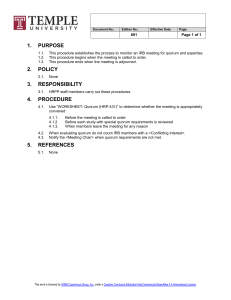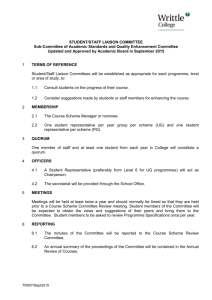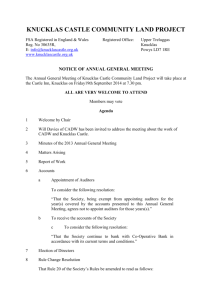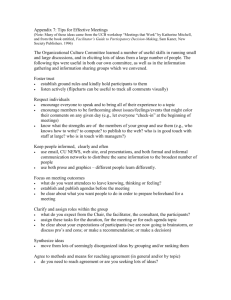6-Location
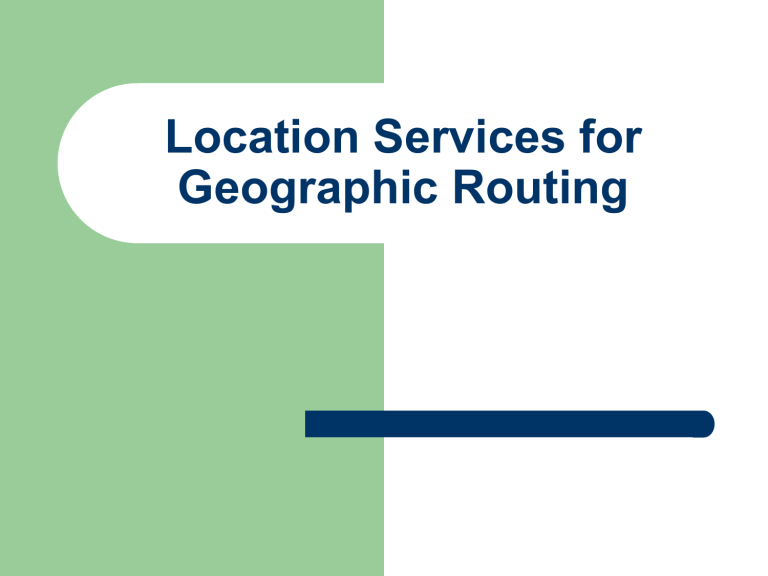
Location Services for
Geographic Routing
Geographic Routing
Three major components of geographic routing:
Location services (dissemination of location information)
Forwarding strategies
Recovery schemes
Problem
Construct and maintain a location database.
Who keep track of whom ?
Some for Some
Some for All
All for Some
All for All
Location Database
Distributed Information Structure
Two major operations
Information Inform/Update ( write )
Information Request/Query ( read )
Question
Inform set = ?
Query set = ?
Inform Set
X stores its location information in every node in Inform-set(x).
x
Inform-set(x)
Query Set
y consults nodes in Query-set(y) for location information.
x y
Query-set(y)
Requirement
Informset(x) ∩ Query-set(y) ≠ Φ for all x, y x y
Inform-set(x)
Query-set(y)
A Brute-Force Scheme
All for All
Inform-set(x) = {all nodes}
Query set(y) = {y}
Example: DREAM
Quorum-Based Location Database:
Basic Idea
U = A set of nodes
Quorum : any subset of U
Quorum system : a collection of pair-wise intersecting quorums
Inform-set(x) = any quorum
Query set(y) = any quorum
Design Issues: construction and maintenance of U and a quorum system
Example
Quorum System
Quorum = one row + one column
1 4 16
1 4 16
1 2 3 4
5 6 7 8
9 10 11 12
13 14 15 16
1 2 3 4
5 6 7 8
9 10 11 12
13 14 15 16
A Quorum-Based Location Service
Zygmunt J. Haas and Ben Liang, “Ad Hoc Mobility
Management With Uniform Quorum Systems,”
ACM/IEEE Trans. On Networking, April 1999.
Ben Liang and Zygmunt J. Haas, “Virtual Backbone
Generation and Maintenance in Ad Hoc Network
Mobility Management,” INFOCOM 2000.
U = ?
U = a set of nodes such that every node is within r-hops of U.
Called r-virtual backbone .
Called dominating set if r = 1 .
Backbone Generation
Similar to domination set generation
Nodes: Backbone , Bridge , Covered ,
Uncovered backbone
Constructing a backbone: basic idea
Initially, Backbone contains a single node.
Bridges keep entering Backbone until no more bridges.
Backbone
Required for the algorithm
r-zone: the neighborhood within r hops
Every node maintains its r-zone
e.g. using the link-state algorithm.
Maintenance of Backbone
If network topology changes
Backbone changes
Quorum-Based Location Database
U = {nodes in backbone}
Quorum : a subset of U
Quorum system : a collection of pair-wise intersecting quorums
Inform-set(x) = any quorum
Query set(y) = any quorum
Maintenance of Quorum System
Backbone may change
Quorum system may change
Maintenance of quorum system is nontrivial
Conclusion
Location services based on Quorum
Systems seem too complicated.
So?
Probabilistic/Randomized Quorum
Systems
Randomized Quorum Systems
Malkhi et al., “Probabilistic Quorum Systems, ” Information and
Computation 170 , 184 –206 (2001). Also, PODC 1997.
Zygmunt J. Haas and Ben Liang, “Ad-Hoc Mobility
Management with Randomized Database Groups,” ICC 1999.
Jiandong Li, Zygmunt, J. Haas, and Ben Liang, “Performance
Analysis of Random Database Group Scheme for Mobility
Management in Ad hoc Networks,” ICC 2003.
S. Bhattacharya, “Randomized Location Service in Mobile Ad
Hoc Networks,” MSWiM'03.
H. Lee, J.L. Welch, N.H. Vaidya, “Location Tracking Using
Quorums in Mobile Ad Hoc Networks,” Aug 2003.
Basic Result [Malkhi et al., 1997]
U = a given set of nodes.
0 ≤ p ≤ 1.
Random quorum of size k : any randomly selected subset of U of size k.
Given U and p, it is possible to choose k such that for any two random quorums, A and B, of size k, Prob(A ∩ B ≠ Φ) ≥ p .
Random-Quorum-Based Location
Database [Haas and Liang, ICC 1999]
U = {nodes in a virtual backbone}
These nodes serve as location servers
Inform set(x) = any random quorum of size k.
Query set(x) = any random quorum of size k.
Access strategy: repeat queries until success.
Performance studies
Performance Analysis [Li et al, ICC 2003]
Update cost
Query cost
Total cost
Update rate ( λ u
)
Query rate ( λ q
)
How does total cost depend on ( λ q
/ λ u
) and quorum size?
Optimum quorum sizes
Different query strategies
Randomized Location Service
[ S. Bhattacharya, MSWiM'03]
Two schemes for constructing a quorum:
1: randomly choose k nodes
2: randomly choose a path of k nodes
Similar accuracy for dense networks.
Quorum size : depends on desired accuracy.
Lower communication cost and query delay time for scheme 2.
Location Tracking Using Quorums
[Lee, Welch, Vaidya, Aug 2003]
Comparing three kinds of quorum systems
U = {1, 2, …, n}
1 2 3 4 1 2 3 4
5 6 7 8 Biquorum system 5 6 7 8
Update quorums 9 10 11 12
Query quorums 13 14 15 16
Update quorum ∩ Query quorum ≠ Φ
9 10 11 12
13 14 15 16
Traditional quorum system
Random quorum system
Random-quorum-based performs best
GLS: Grid location Service
“A Scalable Location Service for Geographic Ad hoc Routing”
J. Li, J. Jannotti, D. Couto, D. Karger, R.
Morris
MIT
Mobicom 2000
Model
Dense deployment of nodes in a rectangular area
Nodes have unique ID
Nodes know their own location information
Geographic Hierarchy of the Network order-2 not order-2 order-3 order-
1 order-
1 order-
1 order-
1
Location Servers
Every node maintains its current location in the following location servers:
Every node in the same order-1 square
One node in every sibling order-1 square
One node in every sibling order-2 square
One node in every sibling order-3 square, etc.
Who knows whom?
Selecting Location Servers
If node x has a server in an area A , it is: f(x, A) = the node in A whose ID is circularly closest to x from the above .
4, 9, 15
17
11, 19, 35
39, 45, 50,
51
x y
Query: where is x?
y asks y’ =f(x,order-1(y)) y’ asks y’’=f(x,order-2(y’)) y’’ sks y’’’=f(x,order-3(y’’))
Does y know y’?
Does y’ know y’’?
Does y’’ know y’’’?
Answer: yes x y’’’ y’’ y’ y
Query: where is x?
17
29
39
49
33
44
19
38
55
24
30
41
56
28
40
45
15
x y
How does x update Location
Information?
x sends an update message to each area.
Who is supposed to know x?
Home-Region Based Location Service
Each node x is assigned a home region H(x). Every node in H(x) serves as x’s location server.
H(x) x x
Combining GLS with Home-Region
“A Scalable Location Management Scheme in Mobile Adhoc Networks,” LCN 2001
“SLALoM: A Scalable Location Management
Scheme for Large Mobile Adhoc Networks,”
WCNC 2002
SLALoM
Unit square, order-1 square, order-2 square, etc.
SLALoM
Each node has a home region (blue shade) in each order-1 square.
y z x u
SLALoM
x, y, z know of u’s whereabouts to the accuracy of unit square, oder-1 square, order-2 square, respectively.
y z x u
SLALoM
x: a node in one of u’s home regions
If u and x are in the same order-k square, but different order-(k-1) squares, then x knows which order-(k-1) square contain u.
u
Order k-1
Order k x
Order k-1
